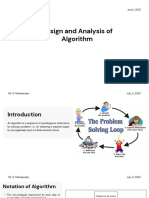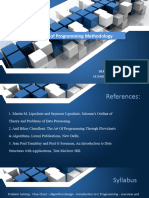0 ratings0% found this document useful (0 votes)
2 viewsc language notes
The document outlines the course 'Problem Solving Using Computers' for B.Tech first-year students, detailing its importance in logical thinking, software development, and programming. It explains the problem-solving process, the significance of algorithms, and their properties, along with examples and flowchart representation. The course is taught by Assistant Professor Virendra Kumar Meghwal in the Computer Science & Engineering department.
Uploaded by
ekaagrag2006Copyright
© © All Rights Reserved
Available Formats
Download as PDF, TXT or read online on Scribd
0 ratings0% found this document useful (0 votes)
2 viewsc language notes
The document outlines the course 'Problem Solving Using Computers' for B.Tech first-year students, detailing its importance in logical thinking, software development, and programming. It explains the problem-solving process, the significance of algorithms, and their properties, along with examples and flowchart representation. The course is taught by Assistant Professor Virendra Kumar Meghwal in the Computer Science & Engineering department.
Uploaded by
ekaagrag2006Copyright
© © All Rights Reserved
Available Formats
Download as PDF, TXT or read online on Scribd
You are on page 1/ 44
B.
TECH FIRST YEAR
ACADEMIC YEAR: 2024-2025
Course Name: Problem Solving Using Computers
Course code : CSE 1002
Faculty : Virendra Kumar Meghwal
Designation : Assistant Professor
Department : Computer Science & Engineering
Email-id : virendra.meghwal@jaipur.manipal.edu
Problem Solving
• Problem-solving is the process of identifying a problem,
analyzing it, and finding an effective solution.
• It is a critical skill in computing, engineering, business,
and everyday life.
• The term problem solving is used in many disciplines,
sometimes with different perspectives and often with
different terminologies.
• The problem-solving process starts with the problem
specification and end with a correct program.
Why Problem Solving is important?
• Helps in logical thinking and decision-
making.
• Essential for software development and
programming.
• Enhances the ability to break complex
problems into manageable parts.
• Improves efficiency and innovation in
various fields.
Problem Solving in Programming
• In programming, problem-solving involves
writing algorithms and flowcharts before
coding.
• Algorithms give a structured plan, while
flowcharts visually represent the logic.
(or)Design an Algorithm
(or) Test the problem
Stages of Software Development
Problem Analysis:
• Analysis the problem or analysis involves the following: ?
– Inputs (i.e. The data you have to work with.)
– Output(i.e. Desired Result)
– Any additional requirements on the Solution.
Algorithm
– An Algorithm is a step-step procedure to solve
a given problem.
– The word algorithm originates word ‘algorism’
which means process of doing arithmetic with
Arabic numerals.
– Around 825 AD, Persian scientist and polymath
Muḥammad ibn Mūsā al-Khwārizmī , who
develop methods for solving problem which is ,
used specific step by step instructions.
Algorithm
Algorithm (English) Pseudocode Algorithm
1. Input first number in variable 1. A = (first input value)
A.
2. B = (second input value)
2. Input second number in
variable B. 3. Initialize sum =0 and avg
3. Initialize sum variable with =0.
zero. 4. sum = A + B
4. Initialize avg variable with
zero.
5. avg = sum/2
5. Add A and B and store in sum. 6. Print avg.
6. Divide the sum value by 2 and
store in avg.
7. Print avg.
Why Are Algorithms Important?
• Helps break down complex problems.
• Ensures correctness before coding.
• Improves efficiency and debugging.
• Can be implemented in multiple
languages.
Algorithm
• An algorithm is a method of representing the step-
by-step procedure for solving a problem.
• Properties of algorithm: An algorithm must
possess the following properties:
1. Finiteness
2. Definiteness
3. Effectiveness
4. Generality
5. Input/Output
Algorithm Properties
1. Finiteness: An algorithm should terminate
in finite number of steps.
2. Definiteness: Each step of the algorithm
must be precisely stated.
3. Effectiveness: Each step must be effective,
in the sense that it should be easily
convertible into program statement and can
be performed exactly in a finite amount of
time.
Algorithm Properties
4. Generality: The algorithm should be
complete in itself, so that it can be used to
solve all problems of a given type for any
input data.
5. Input/Output: Each algorithm must take
zero, one or more quantities as input data
and yield one or more output values.
Example
• Suppose we want to find the average of
three numbers.
• The algorithm can be written as follows:
1. Read 3 numbers a, b and c.
2. Compute the sum of a, b and c.
3. Divide the sum by 3
4. Store the result in variable d.
5. Print the value of d
6. End the program.
• Flowchart is a diagrammatic representation of an algorithm.
It is built using different types of boxes and symbols. The
operation to be performed is written in the box. All symbols
are interconnected by arrows to indicate the flow of
information and processing.
On Page connector vs Off page connector
Off Page Connector
Page i page i+1
Same page
You might also like
- Programming Fundamentals: Bs-Cs 1 SemesterNo ratings yetProgramming Fundamentals: Bs-Cs 1 Semester17 pages
- Introduction To Problem Solving and Programming Course Code: CSE 1021No ratings yetIntroduction To Problem Solving and Programming Course Code: CSE 102196 pages
- 22CS110 - 210-Unit-1 - Art of Programming Through Algorithms and Flowcharts100% (1)22CS110 - 210-Unit-1 - Art of Programming Through Algorithms and Flowcharts7 pages
- Problem Solving Technique using ComputerNo ratings yetProblem Solving Technique using Computer29 pages
- Fundamentals of Algorithmic Problem SolvingNo ratings yetFundamentals of Algorithmic Problem Solving13 pages
- Unit 1: Introduction To Programming Language ConceptsNo ratings yetUnit 1: Introduction To Programming Language Concepts20 pages
- MAT-Lecture-7 - Algorithms & FlowchartsNo ratings yetMAT-Lecture-7 - Algorithms & Flowcharts28 pages
- Lesson 10 - Introduction To Computer Programming (Algorithms and Flowcharts)No ratings yetLesson 10 - Introduction To Computer Programming (Algorithms and Flowcharts)26 pages
- Algorithm-and-Complexity-Flowchart-proceduresNo ratings yetAlgorithm-and-Complexity-Flowchart-procedures9 pages
- Note Book Laptops: 1. HP 15 - Intel CeleronNo ratings yetNote Book Laptops: 1. HP 15 - Intel Celeron3 pages
- C: Client-Independent: Abap Certification QuestionsNo ratings yetC: Client-Independent: Abap Certification Questions23 pages
- Step by Step: Lesson Plan On Scratch Programming: BackgroundNo ratings yetStep by Step: Lesson Plan On Scratch Programming: Background7 pages
- CS217 - Object-Oriented Programming (OOP) Assignment # 1: Carefully Read The Following Instructions!No ratings yetCS217 - Object-Oriented Programming (OOP) Assignment # 1: Carefully Read The Following Instructions!2 pages
- The Study On Resolutions of STRIDE Threat ModelNo ratings yetThe Study On Resolutions of STRIDE Threat Model3 pages
- Architectural Design: Presentation Sub TitleNo ratings yetArchitectural Design: Presentation Sub Title20 pages
- General Keyboard Shortcuts: To... Use This ShortcutNo ratings yetGeneral Keyboard Shortcuts: To... Use This Shortcut4 pages
- COMP 312 COMPUTER NETWORKS - kabarak universityNo ratings yetCOMP 312 COMPUTER NETWORKS - kabarak university6 pages
- Microsoft Excel - Intermediate Level-89 Nov 23 - CompressedNo ratings yetMicrosoft Excel - Intermediate Level-89 Nov 23 - Compressed5 pages
- St. Xavier'S College: Database Management System Lab Assignment #2No ratings yetSt. Xavier'S College: Database Management System Lab Assignment #27 pages
- Introduction To Problem Solving and Programming Course Code: CSE 1021Introduction To Problem Solving and Programming Course Code: CSE 1021
- 22CS110 - 210-Unit-1 - Art of Programming Through Algorithms and Flowcharts22CS110 - 210-Unit-1 - Art of Programming Through Algorithms and Flowcharts
- Unit 1: Introduction To Programming Language ConceptsUnit 1: Introduction To Programming Language Concepts
- Lesson 10 - Introduction To Computer Programming (Algorithms and Flowcharts)Lesson 10 - Introduction To Computer Programming (Algorithms and Flowcharts)
- C: Client-Independent: Abap Certification QuestionsC: Client-Independent: Abap Certification Questions
- Step by Step: Lesson Plan On Scratch Programming: BackgroundStep by Step: Lesson Plan On Scratch Programming: Background
- CS217 - Object-Oriented Programming (OOP) Assignment # 1: Carefully Read The Following Instructions!CS217 - Object-Oriented Programming (OOP) Assignment # 1: Carefully Read The Following Instructions!
- General Keyboard Shortcuts: To... Use This ShortcutGeneral Keyboard Shortcuts: To... Use This Shortcut
- Microsoft Excel - Intermediate Level-89 Nov 23 - CompressedMicrosoft Excel - Intermediate Level-89 Nov 23 - Compressed
- St. Xavier'S College: Database Management System Lab Assignment #2St. Xavier'S College: Database Management System Lab Assignment #2
























































































